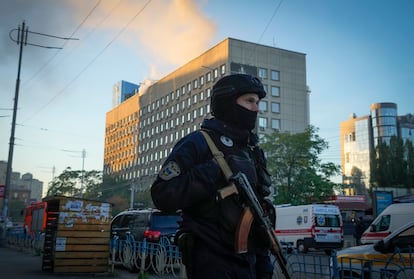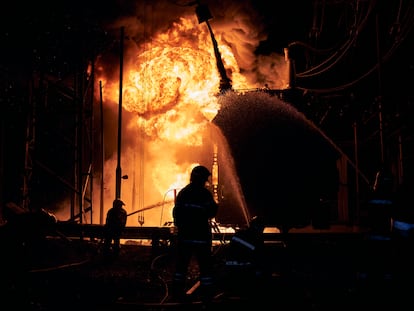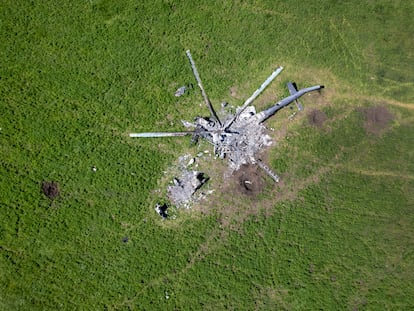Russia strikes Kyiv again using Iranian ‘kamikaze’ drones
At least three people were killed and 20 more injured, according to local authorities. as Moscow continued to target residential areas and critical energy infrastructure

Kyiv was hit by new Russian strikes using Iranian-made “kamikaze” drones on Monday morning, said Andriy Yermak, head of the Office of the President of Ukraine.
Five unmanned vehicles crashed in downtown Kiev, hitting an office building and an apartment block. According to Ukrainian Air Force spokesman Yuri Ignat, the Shahed-136 drones reportedly flew in from neighboring Belarus. At least three people were killed and about 20 more injured, according to reports local authorities.
Around 18 people were rescued from a residential building in the Shevchenkiv district, Kyiv Mayor Vitali Klitschko reported on the messaging app Telegram. “According to preliminary information, two people remain under the rubble. Rescue operations are ongoing,” he wrote. However, the main target of the attack was a facility run by Ukrenergo, the state-owned company that operates the Ukrainian power grid.
The Ukrainian Armed Forces claimed early Monday morning to have shot down 37 Shahed drones across the country since Sunday night, in what they consider to be the largest wave of attacks by Russian unmanned aerial vehicles since the beginning of the war.
Moscow has been stepping up its strikes against civilian targets ever since a key bridge connecting the occupied Crimea peninsula to Russia was partially blown up on October 8, in an attack that Russian President Vladimir Putin attributed to Ukraine.
Monday’s strikes came after Ukrainian authorities denounced Russian bombing in the east and near Kyiv on Saturday, and despite the fact that Putin on Friday said he didn’t see the need to continue “massive” attacks for the time being.
Ukrainian President Volodymyr Zelenskiy reacted to the latest attacks on social media, where he wrote that “the enemy can attack our cities, but it won’t be able to break us.”

Besides residential areas, Russian drone attacks have also been targeting key civil infrastructure, notably energy facilities. Ukraine’s national energy company has warned that the power supply to the capital city and surrounding regions could fail due to severe damage to critical infrastructure. Russian forces also launched at least a dozen missile and drone attacks that damaged energy infrastructure facilities in southeastern Ukraine near Zaporizhzhia, and deployed five Iranian-made drones in the neighboring province of Dnipropetrovsk.
British intelligence experts said in an update on Sunday that last week’s massive attacks, Russia’s defense industry is “probably incapable of producing advanced munitions at the rate they are being expended.”
“These attacks represent a further degradation of Russia’s long-range missile stocks, which is likely to constrain their ability to strike the volume of targets they desire in the future,” added the UK Defense Ministry.
Underage victims
Ukrainian prosecutors said that at least 423 children are dead and 810 more injured as a result of the war that began when Russia launched its “special operation” in February. The areas with the highest number of casualties are in eastern Ukraine, where Russia recently annexed several territories following sham referendums.
A new UNICEF report confirmed that children are bearing the heaviest burden of the economic crisis caused by the war in Ukraine. “While children make up 25% of the population, they account for nearly 40% of the additional 10.4 million people experiencing poverty this year,” warned the report.
And US Secretary of State Antony Blinken, speaking on World Food Day on Sunday, alerted that the war in Ukraine could add another 70 million people to the approximately 190 million already driven into acute food insecurity.
Tu suscripción se está usando en otro dispositivo
¿Quieres añadir otro usuario a tu suscripción?
Si continúas leyendo en este dispositivo, no se podrá leer en el otro.
FlechaTu suscripción se está usando en otro dispositivo y solo puedes acceder a EL PAÍS desde un dispositivo a la vez.
Si quieres compartir tu cuenta, cambia tu suscripción a la modalidad Premium, así podrás añadir otro usuario. Cada uno accederá con su propia cuenta de email, lo que os permitirá personalizar vuestra experiencia en EL PAÍS.
¿Tienes una suscripción de empresa? Accede aquí para contratar más cuentas.
En el caso de no saber quién está usando tu cuenta, te recomendamos cambiar tu contraseña aquí.
Si decides continuar compartiendo tu cuenta, este mensaje se mostrará en tu dispositivo y en el de la otra persona que está usando tu cuenta de forma indefinida, afectando a tu experiencia de lectura. Puedes consultar aquí los términos y condiciones de la suscripción digital.










































